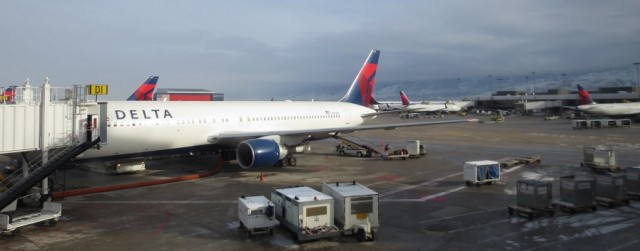
Time to earn some miles on Delta. Image by Mal Muir.
In the first three parts (LEG 1 & LEG 2 and LEG 3) of my mileage run series I talked about what a mileage run is, why you would go on a mileage run and I also spoke about why I got into the mileage game. What hasn’t been talked about yet is what it is like to actually go on a mileage run.
Mileage runs can be fun, they can be interesting, but one thing that is certain is that you will spend a lot of time in those airline seats.
I have already completed two mileage runs earlier this year; one to Dallas (DFW) and another to Newark (EWR). Even though both of the mileage runs were on Delta, one gave me quite a lot more points, as the Newark run was in First Class (thanks to a cheap K Up fare, but that is a story for another day).
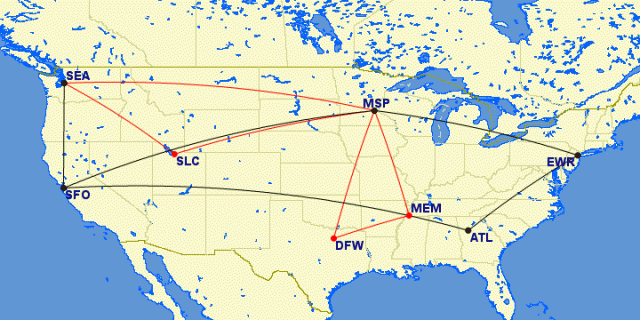
The two different mileage runs I did. To Dallas (in Red) and to Newark (in black)
The Dallas run had me away from Seattle for just 1 night, with three flights each day going from Seattle to Salt Lake City to Minneapolis to Dallas on day one. Day two had me flying Dallas to Memphis to Minneapolis to Seattle. The Dallas run had me visiting three new airports (MEM, DFW & SLC), flying two new aircraft types (CRJ-900 and MD-90) but there were some very tight connections: 45-60 minutes at each airport.
I booked my tickets with the minimum time legally allowed, which probably was not so smart! It made for some interesting times that weekend with me having to run from Gate F7 to C17 in Minneapolis (MSP) to make my flight to Dallas. I made the flight with 5 minutes to spare and covered the distance between gates (roughly ½ to ¾ of a mile) in about 6 minutes. Making the flight meant I could enjoy some BBQ in Dallas before a good night’s sleep.
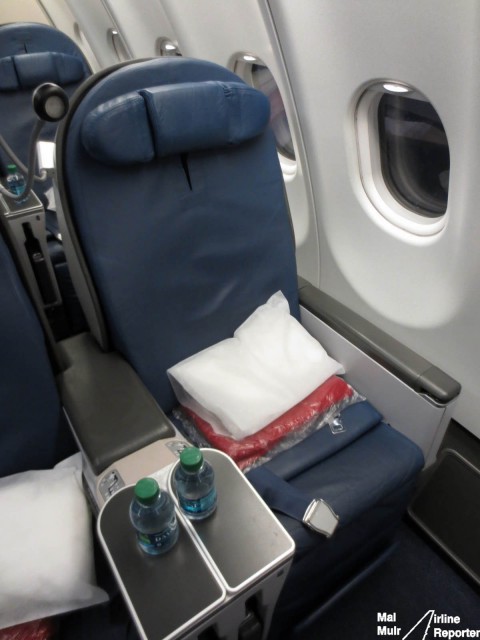
The First Class seat may make mileage running a little bit more comfortable – Photo: Mal Muir | AirlineReporter.com
The Newark run though was much longer. More time between flights and I had to position down to San Francisco. With Seattle to San Francisco on United and my run from SFO to Atlanta to Newark, returning back to San Fran via Minneapolis, this run was definitely a lot more comfortable. However the killer was the five hour layover in San Francisco on the way home. It did give me plenty of time to relax in lounges, explore the airports but there were two very sleepless nights.
The lack of sleep, the long waits in the terminals, getting back to Seattle close to midnight after leaving Newark almost 18 hours prior was a challenge, but still all worth it for me. I was lucky enough to get First Class seats on these flights and was being fed and watered on each leg, but it still was quite a bit of time spend inside an airline cabin.
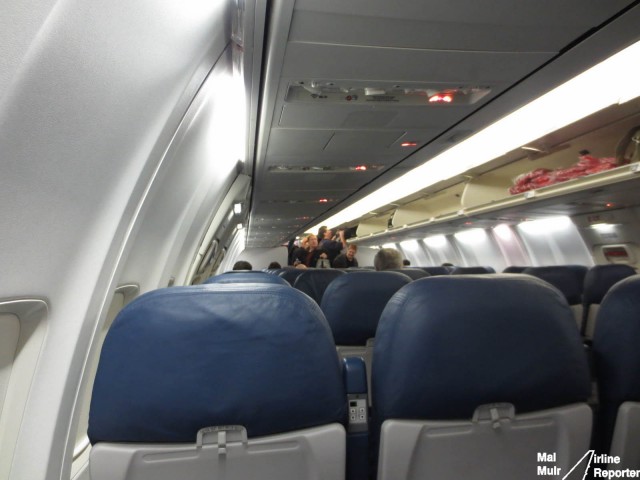
A common site for mileage runners. The back of the seat in front of you. Get used to it! – Photo: Mal Muir | AirlineReporter.com
No matter what kind of run you do, you’re going to want to make sure you plan accordingly. You definitely don’t want to have a checked bag as then you can’t take a bump here or there to help out on the costs (none offered on my flights). You need to stay hydrated and fed so snacks and plenty of water help (biscoffs from the lounges kept me going on the Dallas run). The biggest thing is you need to stay entertained.
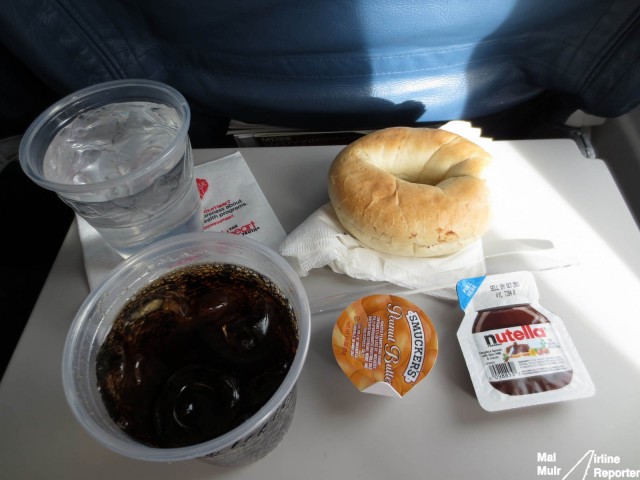
Staying hydrated and nourished on a flight means getting food however you can get it. A breakfast thanks to the Delta SkyClub
You can’t rely on airline provided entertainment, such as seat back TV or WiFi as most of the time it is not fitted or they might not work. So a laptop/ipad with some videos is a good choice. The things that I found worked perfectly were a good book/magazine, which never need charging. Make sure to wear good comfy clothes as you’re going to spend long hours in them… running shoes might help too!
Even though the mileage runs took two full weekends to complete, it gave me more than enough points to re-qualify for my status with Virgin Australia. I earned more than I thought I would with the Dallas run and then earned more than half of my year’s worth of points on that one run to Newark.
Then I was able to do a mini mileage run during my recent trip to Australia (future stories coming soon), to get my four minimum segments and I am set for another 12 months.
I know putting this mileage run into words might make this sound, no so exciting, but try taking a look at my photos of this mileage run and telling me it was not a fun time!
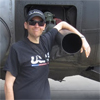 |
This story written by…Malcolm Muir, Lead Correspondent.
Mal is an Australian Avgeek now living and working in Seattle. With a passion for aircraft photography, traveling and the fun that combining the two can bring. Insights into the aviation world with a bit of a perspective thanks to working in the travel industry.
@BigMalX | BigMal’s World | Photos |
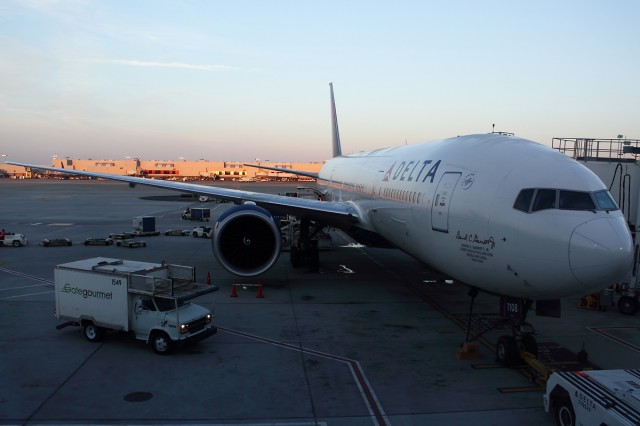
Delta Boeing 777-200LR in Atlanta. Notice the special signature on the nose. Photo by Brandon Farris.
I recently had the opportunity to fly from Atlanta (ATL) to Los Angeles (LAX) on Delta Air Lines flight 110, that was operated by a Boeing 777-232LR. Being the AvGeek that I am and having never flown on a 777 I just couldn’t turn this opportunity down.
I hopped on a red eye out of Seattle (SEA) that got into ATL at 05:30am giving me nearly 3 hours for my connection. I believe it literally took me maybe 20 minutes to get from where my SEA plane was parked in the B gates to gate F4 where I lay eyes on N708DN, a 2009 777-232LR that would be my ride back to the west coast. This aircraft is dedicated (with a special logo on the nose) to Delta’s former CEO David C. Garrett Jr who served for the airline from 1978-1987.
Being that I was at the airport so earl,y not many shops were open yet, so I mingled around the terminal where I saw a Boeing 767-432 arrive from Rio as DL60 and an Airbus A330-323 pushed back at 06:10am and depart as DL8860 to Saint Martin which was a surprise.
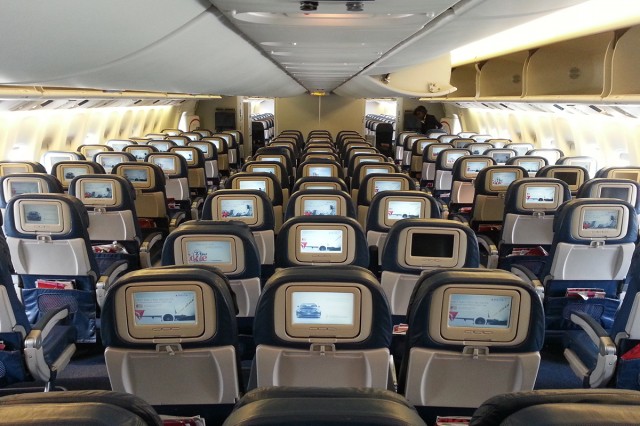
Delta configures their 777’s in a 3-3-3 layout. Photo by Brandon Farris.
Gate agents finally arrived around 07:00AM for our 08:10AM departure, at this point I was assigned 53E which is literally middle middle on this aircraft as it is a 3-3-3 configuration in the coach cabin.
It finally approached time to board, but were told that there was a slight delay with the cleaning crews onboard the aircraft and boarding would begin as soon as possible. Once boarding began I waited until the very end to get on since all I had was a backpack and wouldn’t require any overhead space.
Walking down the jetway the excitement began to settle in that I was about to step foot on my first ever 777 flight even if it was domestic, it is still a 777. By the time I boarded near the end, it didn’t take very long to get to my seat near the very back of the aircraft.
The time was now 0819 and our push-back began, only 9 minutes late so not too shabby. This was the part that I was most looking forward to; that howling growl start of those amazing General Electric GE-90’s as they spool up and come to life. I heard the first one start and it was like music to my hears. I know that I had the biggest and dorkiest smile/look on my face like a 5 year old. Yes I am in love with that howl!
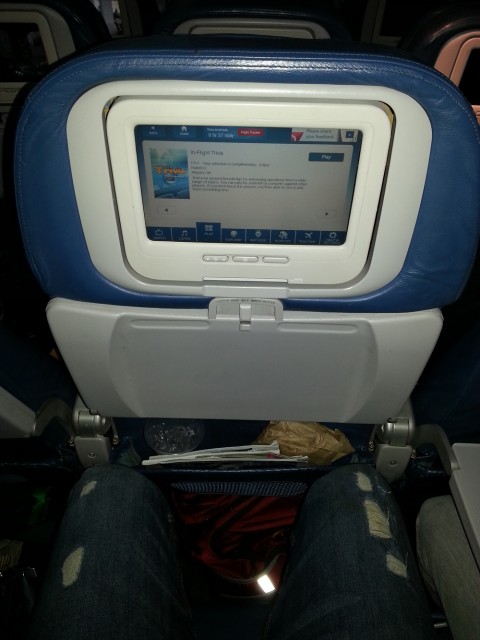
Delta’s Economy in-flight entertainment. Photo by Brandon Farris.
Following the push-back, we begin our taxi out. The pilot came on the intercom and alerted us that we are number five for departure, 19 minutes after departing the gate the aircraft begins to turn on the runway. I was ready to feel the full 220,000lbs of thrust but since we were so light with only going to LAX the pilots really didn’t seem to throw the throttle that high. It didn’t seem very long for us to climb to our cruise altitude of FL400 as we headed west. I must admit that this was one of the quietest cabins I have flown on at cruise.
Now, I had the opportunity to check out the seats. They seemed very wide which I absolutely loved but at the same time each row is extremely narrow to where my knees were almost in the seat in front of me (I am 6’0″). I couldn’t imagine if someone had been sitting in front of me and reclining the seat. It would have crippled my space, in a long haul flight I definitely would consider upgrading to the front cabin if possible, but luckily this was a shorter flight.
The lack of leg space however was made up for with the ability to plug my phone in to charge and a seatback TV which had a very wide array of movies to choose from including ones that had just come out on DVD last week like Life of Pi, to classics like The Goonies.
I choose Lincoln, but since I was so tired, I fell asleep about 20 minutes into it and I actually took a nap for about 3 hours. When I woke up, the cabin crew was coming through with a final beverage service. As a part of the service, they offered three choices for snacks: pretzels, peanuts or the infamous biscoff cookies. This was a welcome change as I am just used to the standard AM or PM snack depending on when my flight was.
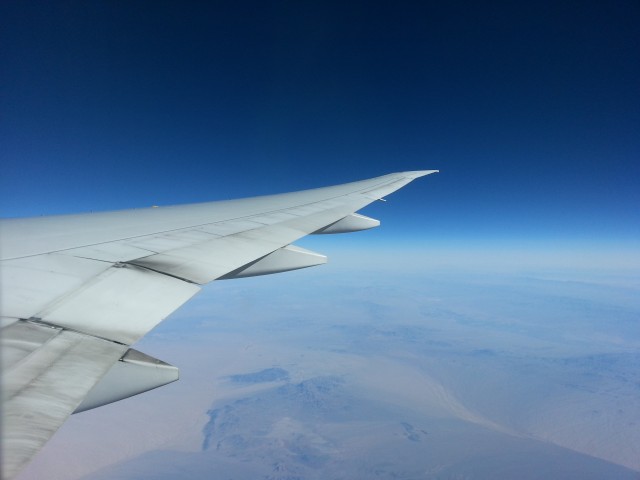
Flying on the 777. Photo by Brandon Farris.
At this point we were now about 40 minutes out from LA so I decided to get up and stretch a little and see if I could find a window to peak out somewhere and at least get a couple of pictures and was lucky to find that the cabin doors all have windows and was able to snap away for a couple of minutes. I also took this opportunity to visit the lav to find it was surprisingly very spacious.
But now it was time for me to return to my seat as we began our descent into LAX and was a fairly smooth approach. We landed on 25L and the pilots brought us in very gently before I was able to hear the roar of that GE-90 as the thrust reversers were kicked in. Following a short taxi we parked at the gate at 0957, three minutes early even after the late push.
Deplaning was brief, only being about 15 minutes from the back of the plane. I had the opportunity to talk to the pilots and was invited to make a brief visit to the flight deck before finally leaving the aircraft.
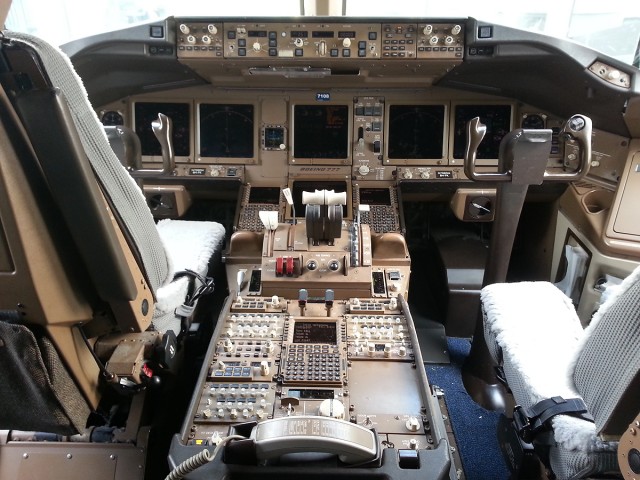
Flight deck of the 777. Photo by Brandon Farris.
Overall for this being my first time ever flying on Delta and the Boeing 777 I was extremely impressed on both fronts. The gate agents were extremely friendly which can be rare to find, especially at 0600 and 0700 in the morning. The inflight crew was great and was willing to answer any questions I had. It was nice to see such happy and helpful employees working for Delta after I have heard mixed reviews. Now to try and test out the 777 on a longer flight.
NOTE: Brandon covered the cost of this flight on his own and it was not paid for by Delta.
 |
This story written by…Brandon Farris, Correspondent. Brandon is an avid aviation geek based in Seattle. He got started in Photography and Reporting back in 2010. He loves to travel where ever he has to to cover the story and try to get the best darn shot possible.
@BrandonsBlog | RightStuffPhotography | Flickr |
It is that time of year again for airlines and organizations related to aviation to come out with crazy stories for it being April Fools’ Day. Once again, we will try and track them down and share them. If you see others that are not covered here, leave something in the comments.
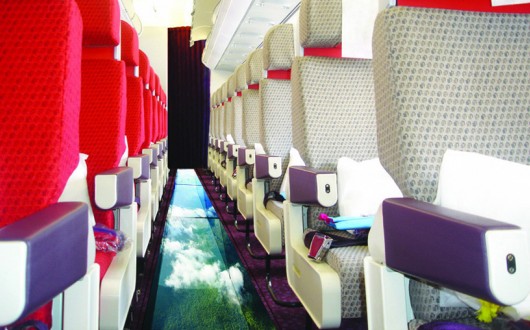
This is something that AvGeeks might like, but probably not most passengers. Image from Virgin Atlantic.
VIRGIN ATLANTIC TO OFFER SEE-THROUGH FLOORS:
From Richard Branson: I’m thrilled to announce that Virgin has created another world-first with the introduction of the technology required to produce the world’s first glass-bottomed plane. This technological innovation coincides with the start of Virgin Atlantic Airways’ first ever domestic service to Scotland.
In 1984 we started the wonderful airline that is Virgin Atlantic. I am incredibly proud of yet another aviation breakthrough which has been years in the making. I can’t wait to experience the first flight for myself with my family and other natural born explorers.
Read more and see some pretty sweet mock-up photos…
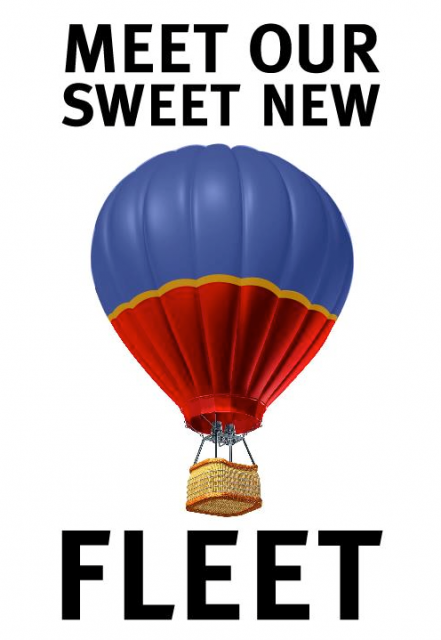
Take a Southwest Airlines hot air balloon. Image from Southwest Airlines.
SOUTHWEST AIRLINES ADDS HOT AIR BALLOONS
From the airline: When you’re flying nearly 500mph at 35,000 feet above ground, life passes by pretty fast. Sure, Southwest has a suite of things to keep you entertained inflight: Video on Demand; WiFi; Live at 35; hilarious Flight Attendants. Heck, we’ve even transported a miniature seeing-eye horse, and a couple endangered sea turtles. But figuratively, you can’t have the hare without the tortoise.
Realizing the possibility that slow and steady may truly win the race, the answer became clear: it was time to float the grandest idea Southwest has ever had. It was time to take things slow. The tortoise and the hare. Hot air balloons and Boeing 737’s, soaring fancy free, albeit at distinctly different altitudes, and at significantly separate speeds.
Read more…
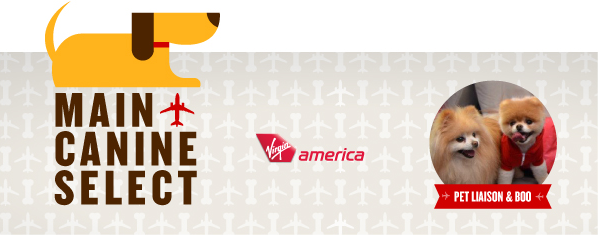
Flying does not have to be “ruff” any longer. Image from Virgin America.
MAIN CANINE SELECT WITH VIRGIN AMERICA
From the airline: We’re of the mind that man’s best friend shouldn’t get the raw deal when flying long distances, so we partnered with Boo, World’s Cutest Dog and our very own Pet Liaison to throw furry flyers a bone. Over the last year (and with Boo’s doggy design expertise) we’ve converted our first class cabin into a space as tricked out as our state-of-the-art digs at SFO’s Terminal 2.
See more images and learn more…

JetBlue adding more destinations? Probably not really these ones. Image from Jeremy Dwyer-Lindgren.
JETBLUE FLYING TO THREE NEW DESTINATIONS
From the airline: We’re excited to announce three tantalizing new destinations, expanding this fun-loving airline’s borders to three new countries and giving travelers more options for flying to some of the farthest-reaching dots on the globe, including:
- April River Airport (APR) in Papua New Guinea;
- Ilford Airport (ILF) in Manitoba, Canada; and
- Gold Coast Airport (OOL) in Coolangatta, Australia
Customers looking to climb an active volcano in Rabaul Caldera, experience a new sub-zero Canadian vacation spot or visit their Coolangattan relatives can now hop a flight with their favorite, customer service-friendly carrier. Once-daily flights to all three new destinations will be offered from our existing stations in Portland, Maine and Aquadilla, Puerto Rico. Twice-weekly flights will also be offered between Papua, New Guinea and Coolangatta, Australia with connecting service in Ilford, Canada(a).
Keep reading and see video…
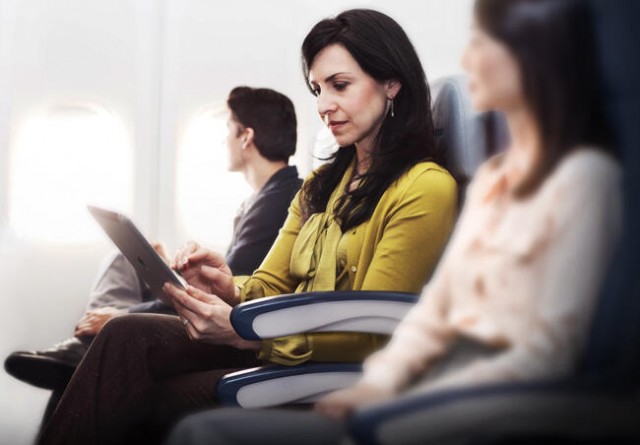
More room for the arms. Image from Delta.
DELTA DOUBLE DECKER ARM REST
Posted on Delta’s Twitter account: Introducing the new Double Decker Armrest coming soon to the middle seat. More arm space. Less elbow rubbing.
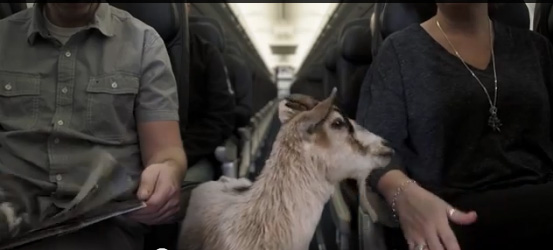
WestJet’s new animal policy might be a Baaaaad idea. Image from WestJet’s video.
ALL ANIMALS ON BOARD WESTJET
From the airline: WestJet today announced the easing of restrictions on pets in the cabin. All WestJet flights will now allow for any type of animal to travel in the cabin provided it fits safely on board the aircraft.
“We recognize that a growing number of families want to travel with their ‘extended’ family and we are proud to be the first airline to offer this type of service,” said Richard Bartrem, WestJet’s Vice-President, Communications and Community Relations.
Thanks Allen for finding this one.
Be sure to check out WestJet’s video…
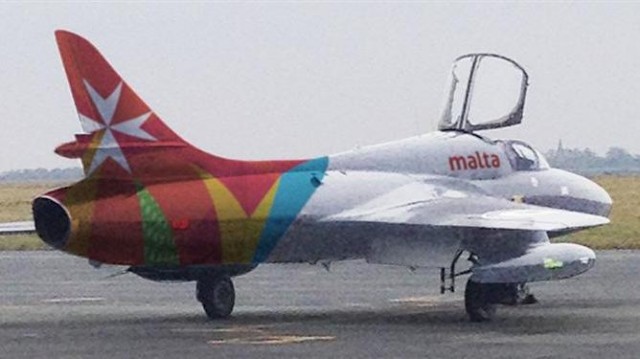
Air Malta to buy a Hawker Hunter?
AIR MALTA BUYS A FIGHTER JET
From the Malta Independent: Air Malta has bought a 1950s privately owned two-seater Hawker Hunter fighter jet. The historic airworthy military aircraft will be painted in Air Malta’s new livery and will be used to generate new revenue streams for the airline. The aircraft will also be used to promote Air Malta and the Maltese Islands abroad by participating in a number of air shows around the world.
Plans have already been made by the airline for a soon-to-be-launched novel product ’˜Jet Fighter Adventure Flights’ – an adrenalin rushing thrill seeking fighter aircraft experience that has become very popular in several countries around the world. These flights-of-a-lifetime will be available for purchase on the airline’s website www.airmalta.com.
With its sleek design, brilliant handling and maneuverability, the Hawker Hunter aircraft will offer customers the opportunity to experience a historic flying adventure. The classic Hunter was one of the best transonic jet fighter aircraft and formed the backbone of the Royal Air Force’s jet fighter squadron in the late 1950s. The aircraft was withdrawn from active service in 1995. During the 1960s and 1970s Hawker Hunter aircraft were a common sight at Malta’s Luqa airfield.
Keep reading…
PREVIOUS AIRLINE JOKSTERS:
Since the inception of the loyalty program, hotels and airlines have worked together. The relationship has always been more that the hotels just providing you points in the airline program if you stay with them. An announcement by Delta Air Lines last month has changed things considerably.
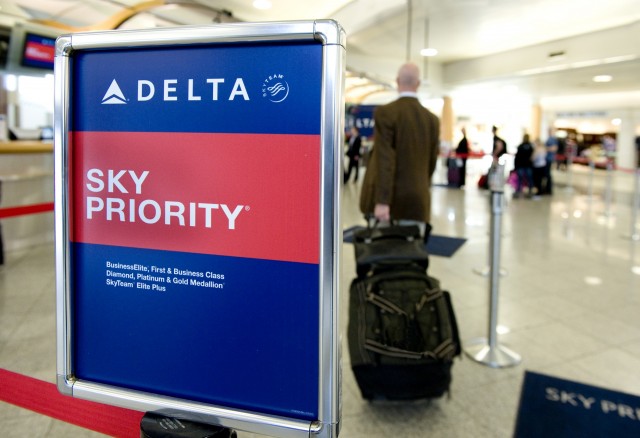
Delta Sky Priority Check In, now for SPG Platinum Elite members. Photo: Delta
Delta’s SkyMiles program has elite tiers that offer a great range of benefits to their frequent fliers including complimentary upgrades, priority boarding, check in along with much more. Starwood’s SPG Preferred Guest (SPG) program has its own elite tiers that offer bonuses like free upgrades, late check-out or complimentary Wi-Fi. The hotel & airline programs have always been similar that they reward their frequent fliers/guests with all the goodies that you want for being loyal.
As of the 1st of March, Delta & Starwood are coming together to create ’œCrossover Rewards’.
Crossover Rewards allows the Delta & Starwood top tier elite members to get similar benefits. If you are a Delta SkyMiles Platinum or Diamond Medallion member you will be able to get extra benefits at a Starwood hotel including late check-out & Free Wi-Fi access. If you are an SPG Platinum member you get benefits with Delta including a free checked bag, and also priority check in & boarding. The biggest alignment in the programs is the points earning ability.
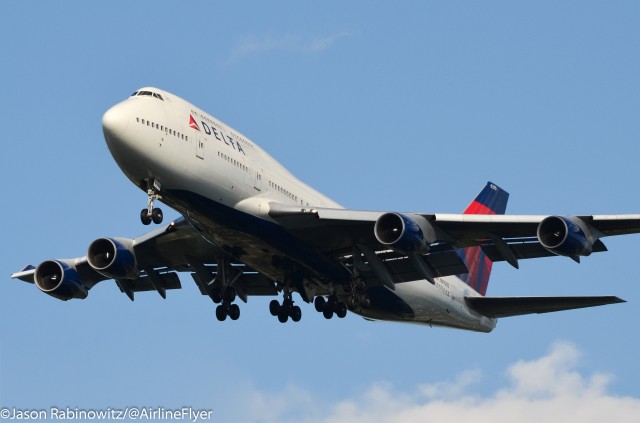
A Delta Airlines 747-400 – Photo: Jason Rabinowitz
Normally if you fly, you can only earn points with one airline or program, the same with hotels. However with Crossover Rewards you get to ’œdouble dip’. If you fly with Delta and have the SPG status you get bonus starpoints AND Delta miles. Delta fliers get the same when they stay at a Starwood property.
“Crossover Rewards is another example of Delta’s commitment to making the travel experience more beneficial and enjoyable for our customers,” said Tim Mapes, Delta’s senior vice president of marketing. “For our loyal customers, hotel accommodations are a vital component of the travel experience, which makes this new alliance with an innovative company like Starwood a strategic addition to the SkyMiles program.”
But then the relationship goes one step further. During enhancements announced by Delta to BusinessElite services on the prime transcontinental market, there was a separate little announcement that seemed to be hidden in the clutter. As of June 1st Delta will be upgrading its Business Elite bedding product to be based on the Westin Heavenly Bed.
What is the Heavenly Bed? In 1999 Westin (part of the Starwood Hotel Group) launched the Heavenly Bed range and then a year later became the first hotel company ever to sell that signature line.
“Delta is committed to providing our customers with the best possible sleep experience in the skies and we’re excited to partner with another leader in the travel category, Westin Hotels and Resorts, who shares this goal,” said Joanne Smith, Delta’s senior vice president of in-flight service. ’œThe new Westin Heavenly In-Flight bedding product is just one of the new amenities Delta is introducing to ensure customers achieve a restful, rejuvenating in-flight experience.”
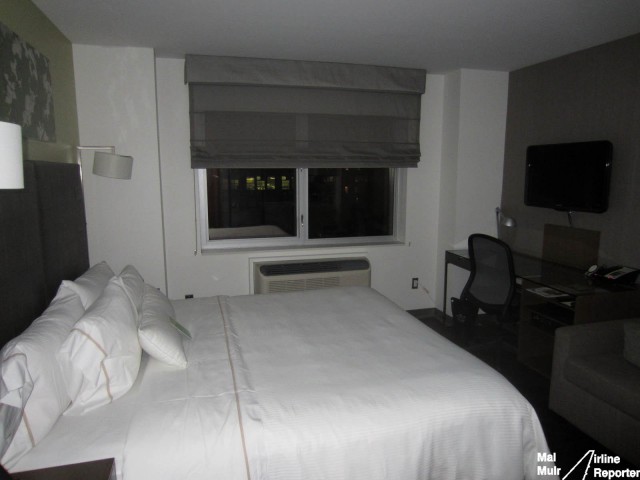
A Westin Heavenly Bed at the Element Times Square West – Photo: Mal Muir | AirlineReporter.com
The new Heavenly Bed products will be launched on all BusinessElite international flights, along with the usual long haul transcontinental routes (JFK-LAX, SFO & SEA) & Atlanta to Honolulu. The new inflight product includes a Westin Heavenly Sleeping Pillow & Comforter with ’œextra luxurious loft’ and for flights over 12 hours (those ultra-long haul international flights) will get an extra lumbar pillow as well.
These two announcements bring together a new relationship that could be an industry lead in this area. Is this a sign of the future? Are we going to see other hotel chains partner up? Maybe American & Marriott or perhaps Motel 6 & Spirit.
 |
This story written by…Malcolm Muir, Lead Correspondent.
Mal is an Australian Avgeek now living and working in Seattle. With a passion for aircraft photography, traveling and the fun that combining the two can bring. Insights into the aviation world with a bit of a perspective thanks to working in the travel industry.
@BigMalX | BigMal’s World | Photos |
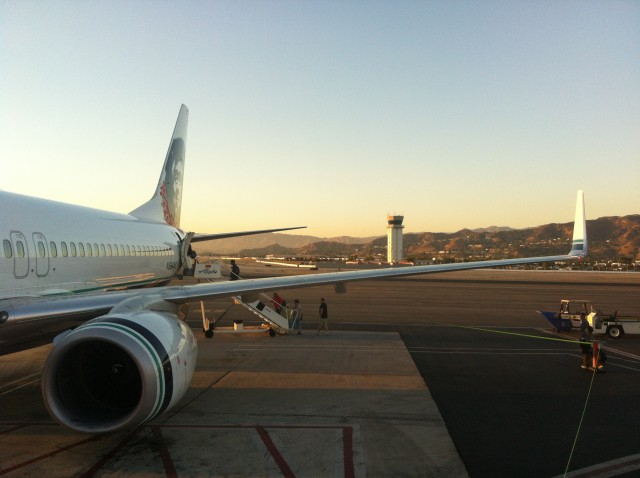
Boarding an Alaska Airlines Boeing 737 at Burbank. Image by Colin Cook.
It used to be that most major airlines shared commonalities in the way they boarded passengers. However it seems that each airline has so their own boarding processes that it’s hard to keep up. Sure, the way an airline boards likely won’t sway a decision on which airline to fly, I wanted to put together a list of how some of the major airlines operate their boarding process.
As one would expect, the majority of airlines give priority boarding to their elite level fliers. Having personally achieved even a low level MVP with Alaska Airlines I can say that I would never want to go back to being just ’œone of the herd.’ While I haven’t gone on a ’œmileage run’, there are many well documented stories of folks taking a quick trip just for the sake of achieving elite-level status.
With precious overhead space and many airlines now charging for checked luggage it’s become a race to get on board as early as possible. While some low cost carriers are now charging for carry-on bags, the major US airlines typically allow one carry-on bag (i.e. a roller bag or other bag for the overhead bin) and one personal item (laptop bag, purse, backpack, etc). Since many travelers are now bringing a large carry-on bag, boarding times have soared. An article in the New York Times suggested that boarding a plane with 140 people in the 1970’s took about 15 minutes which has more than doubled to 30-40 minutes.
Without further adieu, here is how the various airlines handle their boarding procedures (a small note: these are all the boarding requirements as found by AirlineReporter.com at the time of publishing. These change frequently, so please add any changes/ideas to the comments and listen to all gate announcements for proper boarding proceedures):
How does Air Tran board? ’“ This airline’s boarding procedures will undoubtedly change as the integration into Southwest takes place over time. Southwest operates a 737 only fleet and is in the process of subleasing Air Tran’s Boeing 717 planes to Delta. Presently, Air Tran pre-boards unaccompanied minors, passengers traveling with an infant, and passengers needing special assistance prior to general boarding. Like many other airlines, Air Tran utilizes a zone boarding process.
How does Alaska Airlines board? ’“ Being based in the Pacific Northwest, I fly Alaska more than any other airline. Their boarding process is pretty straightforward. They don’t mess around with zones or boarding groups and have a seemingly more streamlined approach. They begin with preboarding ’“ those customers who are traveling with children or need some additional time to get down the jet way. After preboarding, they invite First Class, Alaska Airlines MVP and 75k elite level fliers. Next are passengers seated in row six of the main cabin (bulkhead row at the front of economy) and Alaska MVPs and partner elites. After that, they board from the rear of the plane starting with passengers seated in row 15 and higher. Finally they open to general boarding at that point. It’s a pretty well organized system and tends to work well.
STORY: Flying First Class on Alaska Airlines
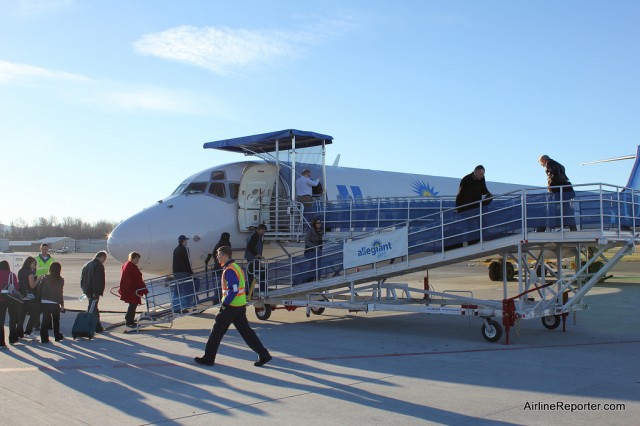
Boarding an Allegiant MD-80 in Bellingham. Image from David Parker Brown / AirlineReporter.com.
How does Allegiant board? ’“ Allegiant offers many different add-ons to their standard fare and does a nice job of providing ala carte service where you can add additional services to their basic fare. Among their options are Priority Boarding for $9.99 (allows you to board first), Premium Seat Selection $9.99 (an assigned seat near the front or exit row), Standard Seat Assignment $6.99 (assigned seat towards the back of the plane). You can certainly opt to fly without paying any of those additional fees, but be prepared to sit in a middle seat. Their boarding process allows people that paid for priority boarding to board first, followed by those who need a little extra time. Then passengers who paid for the standard seat assignment are allowed to board followed by those who do not have seat assignments but have young children. Lastly it goes to open seating and people get to fend for them self to find an open seat.
STORY: Flight review flying Allegiant Airlines
How does American Airlines board? ’“ American is one of the airlines that actually disclose their boarding process on their website. Many airlines do not give a specific process but simply expect you to pay attention when you get to the airport. American employs a process similar to most of the other legacy carriers in that they give priority to elites and then general boarding. Their process consists of preboarding First Class, Uniformed Military, AAdvantage Executive Platinum, and oneworld Emerald. On aircraft with three class service, Business Class is boarded next. The next group consists of AAdvantage Platinum and oneworld Sapphire, followed by Priority AAccess and oneworld Ruby. From there, American is in the home stretch boarding groups 1-4. Of course this could all be changing with the airline merging with US Airways.
STORY: Taking American’s 737 Sky Interior Delivery Flight
How does Delta Air Lines board? ’“ The world’s largest airline by passengers carried and fleet size has developed a good reputation among both business and leisure travelers. They utilize a zone boarding process similar to many of the other large airlines. They first offer preboarding to their Sky Miles Medallion elite level fliers (Diamond, Platinum, and Gold) and passengers traveling in the first class cabin. On international flights they then invite passengers traveling in BusinessElite, Sky Miles Medallion Silver frequent fliers, and partner elites to board. Delta then begins general boarding via a zone process beginning from the rear of the aircraft. Depending on the size of the plane and whether it is an international or domestic flight, Delta can have as many as nine different boarding groups.
How does Frontier Airlines board? ’“ Denver’s hometown airline has been undergoing some big changes in recent years. Frontier uses a zone boarding style similar to many other carriers, beginning with preboarding for passengers with special needs, which include passengers who need assistance and unaccompanied minors. Similarly to Jet Blue’s Silent Boarding group, they do not announce a special boarding for this group. The one nice thing is that you don’t have to make a reservation in advance for the extra time, whereas you do on Jet Blue. Frontier then invites their Summit Members to board which is the top tier of their EarlyReturns frequent flier program. They then begin priority boarding and Zone 1 which includes Ascent members (second tier of EarlyReturns), as well as people traveling on a Classic Plus fare or seated in Stretch seating. Next, they invite families with small children and passengers requiring additional time or assistance to board. They also have a separate boarding group here for people who are not utilizing overhead bins (it pays to pack lightly). After that, they begin boarding with Zone 2, which are passengers in Select seating. Finally, they board Zone 3 which is pretty much anyone else. So while Frontier technically only has three zones, they really have seven different boarding groups.
STORY: Review flying Frontier Airlines to Denver and back
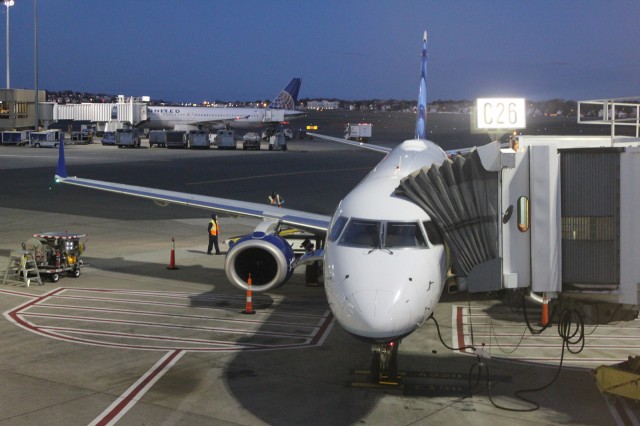
A JetBlue E-190 in Boston. Image from David Parker Brown / AirlineReporter.com.
How does JetBlue board?’“ As is typically true with most things JetBlue, they try to keep their boarding process simple. They begin with pre-boarding which they call Silent Boarding. This is a service that must be requested in advance and is designed for people who have requested or appear to need additional time boarding. The interesting bit is that they do not make a gate announcement (hence the Silent Boarding name), so it is up to you to request this service and show up at the right time. After Silent Boarding they begin priority boarding for Mosaic and Even More Space customers. Mosaic is their elite level program which has many of the same benefits as competitors (priority security lane, preferred seating, 2 free checked bags, bonus points, and dedicated customer service line). Even More Space is an option that you can select when booking and just like it name suggests you get more space.
JetBlue then invites families with children under the age of 2 and other individuals who need additional time to board. It’s interesting that they have their Silent Boarding and then a separate pre-board for people who may need additional time. Finally, they board from the rear of the aircraft forward in five row increments. This begins with individuals in rows 20-25, then 15-25, 10-25, and lastly 5-25.
STORY: Flying JetBlue from the Bahamas to Boston in an E-190
How does Southwest Airlines board? ’“ Southwest is unique since they do not actually assign seats. So it’s still important to get a good boarding group to ensure a good seat and overhead storage. Their overall process contains a boarding group (A, B, or C) and a number (1-60) and they have passengers queue up in the boarding area in a line according to the boarding group and number. Some have called this process a “cattle call,” but really it seems like less people end up standing around waiting to be called than with other methods. Alternatively, you can buy a Business Select or EarlyBird Check-In to be among the first to board. For frequent fliers, it is a pretty simple boarding process, but it seems that people who do not fly often, easily get confused on how to board a Southwest plane.
STORY: Guide to getting a good seat on Southwest Airlines
How does Spirit Airlines board? ’“ Spirit is the ultimate King of low cost travel and their boarding process and baggage policies reflect that. Like Allegiant, their base fares are always amongst the lowest but Spirit is betting you will purchase additional services. They not only have fees for seat selection but also other amenities such as checked baggage and soft drinks on board. Spirit employs a zone boarding process similar to many airlines with some differences. They allow unaccompanied minors and others requiring assistance first, followed by folks sitting in their Big Front Seats (first row or two depending on aircraft that are in a 2-2 layout and have better seat pitch), and then the remaining zones 2, 3, & 4. The one difference is that they board from the front to the back.
How does United Airlines board? ’“ No sooner than I finished writing the original section on United, the airline made yet another change in their boarding process. This marks the fifth time in less than two years that the airline has changed their procedure. This is not surprising as mergers always result in some chaos, but it would seem smart for the airline to stick to one process for a while — hopefully this one will stick.
Under the new process, they begin with pre-boarding of customers with disabilities, Global Services, and uniformed military personnel. Following that, Group 1 is invited to board which included Global Services (for customers that did not pre-board), Premier 1K, Premier Platinum, and their premium cabins. Group 2 is essentially for all of the United and partner elite fliers including Premier Gold and Silver, Star Alliance Gold and Silver, MileagePlus Presidential Plus and Club cardholders, MileagePlus Explorer and Awards cardholders.
It’s interesting that United does not give greater priority to their Gold and Silver level fliers ’“ someone who holds their credit card is given the same boarding priority. United has really been pushing their Explorer credit card so it’s no surprise they used priority boarding as a selling point. United then opens up for groups 3-5 for general boarding from the rear of the aircraft. Unlike other airlines, they no longer give priority boarding to families traveling with infants or young children. Those families must board when their group number is called.
How does US Airways board? ’“ Much like other legacy carriers, US Airways uses a zone boarding process. They begin with preboarding of First Class / Envoy, Preferred members of their Dividend Miles program, and Star Alliance Gold members. After preboarding, zone 1 consists of the bulkhead row and exit row seats without under the seat storage. It’s interesting that they allow exit row seats without under the seat storage to board early. I realize that these folks have responsibilities since they are in the exit row, but does it really take them longer to board?
Zone 2 is made up of US Airways Premier World MasterCard holders, US Airways Visa Signature card holders, ChoiceSeats, and Exit row seats with under-the-seat storage. Much like United, they have given their credit card holders a priority boarding group. At least the elite members of their Dividend Miles program get a higher priority (United has the same boarding priority for Gold and Silver elites as they do for their credit card holders). Finally they board from the rear forward beginning with zones 3-5. It’s a fairly straightforward process which is nice.
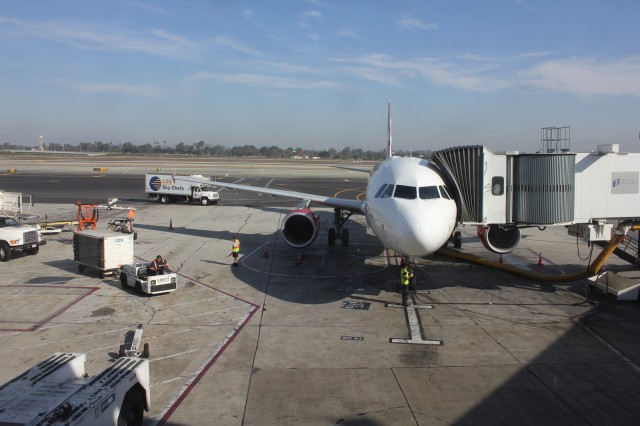
Virgin American Airbus A320 at LAX. Image by David Parker Brown / AirlineReporter.com.
How does Virgin America board? ’“ Virgin American starts with allowing their First Class passengers to board before allowing folks with children and disabled people who need a little more time. Then they move on to Main Cabin Select, which are in the first row of economy and the exit rows so they have more legroom. The Main Cabin Select fare also comes with complimentary food and drinks and one free checked bag. After those two groups, they board the Main Cabin Express group. Ultimately, this is just an add-on that you can purchase to be among the first to board.
Being that I really like to be sit near the front and be able to get off the plane as soon as possible, this fare is quite appealing. Finally, they move on to a group based boarding process, starting with A and moving through the alphabet. I recall on one flight it went groups A-D, but on another it went A-F.
STORY: Flying in Virgin America’s First Class
Hopefully this article can provide some insight the next time you are traveling and are curious about how different airlines board. In the comments, be sure to talk about your boarding experiences and which processes do you like (or hate the most)?
Related links in airline boarding:
 |
This story written by…Colin Cook, Correspondent.Colin is an avid AvGeek who works in finance and is based in the Seattle area. He has an immense passion for aviation and loves to travel as much as possible.
@CRoscoe2121 |


























